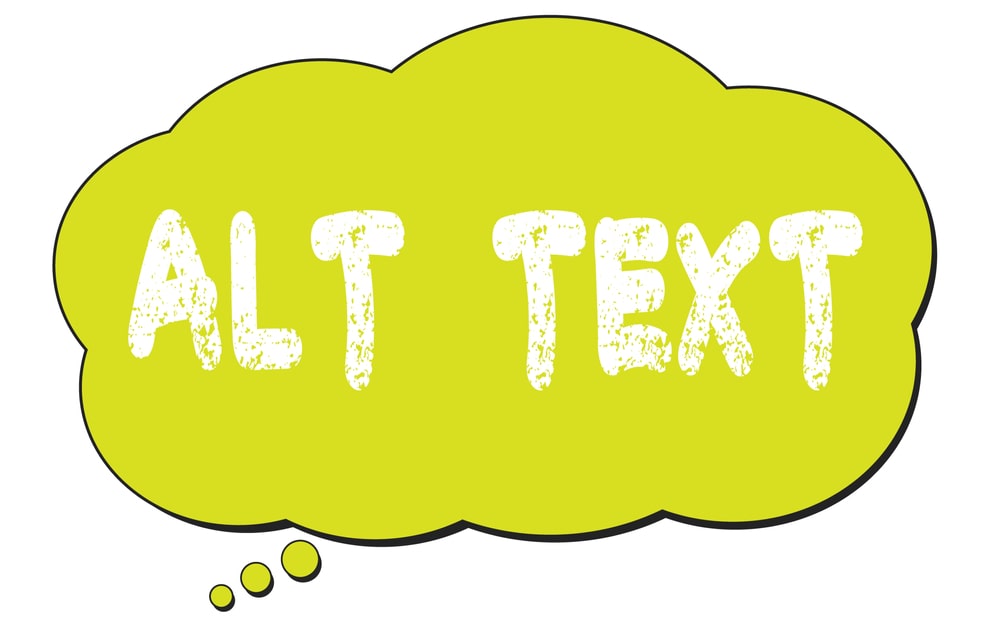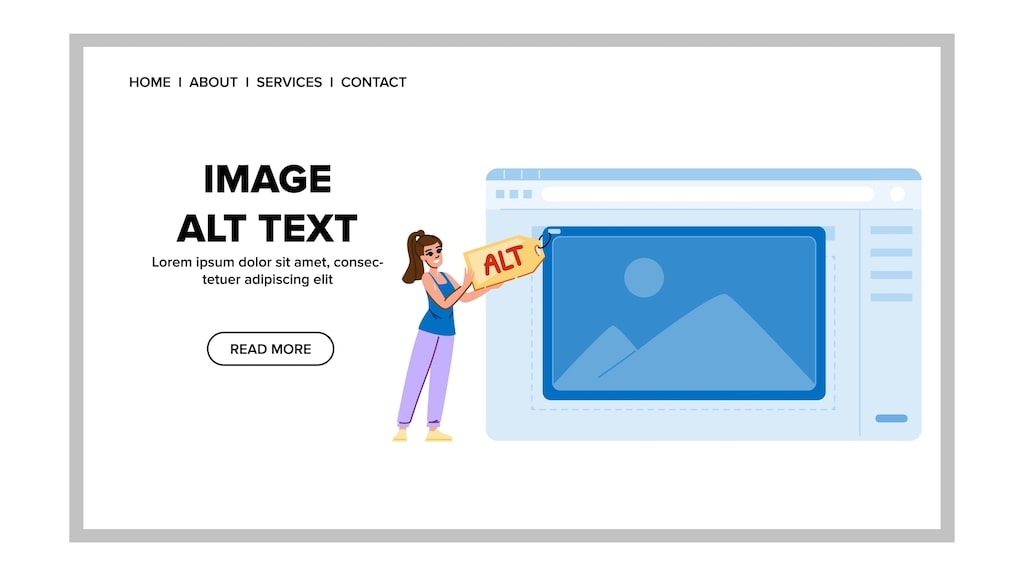To make your web page more accessible, one of the best steps you can take is to write alt text for any images on your page. Alt text, or alternative text, provides information for screen readers so that a screen reader user can identify what the image is. This tool can increase ADA & WCAG compliance and improve the accessibility of a web page.
Our team at Accessibly understands that screen reader users have specific needs that an alt attribute can help with. If you have multiple image files on your website, consider alt tags and a concise description of any complex images to increase web accessibility. We also offer tools that can specifically help developers and designers provide more accessibility.

The importance of accessibility alt text in web design
Making images accessible through image alt text is a major part of accessibility, but what can accessibility do for your site? On a practical level, image alt tags can provide information about the image if the image fails to load. SEO alt text can also help your site appear in search engines, which means that it can help improve SEO optimization.
The most important reason to write alt text, however, is that providing a text alternative to images can expand the number of people who can use your site. Not all visitors use visuals, and some may utilize screen readers and other assistive technologies to access web pages. Providing text alternatives makes your site more accessible for people with visual impairments.
Why alt text is crucial for users with visual impairments and screen reader users
For users with visual impairments, alt attributes can be crucial to navigating and understanding the content of your website. Alt text can provide context and information to those who may not be able to see the image. If the image content is important to the page content, using your content management system to add text to describe the image can help low-vision users.
This can also help distinguish important images from decorative images. Decorative images should have empty alt text, also called null alt text, which can quickly and easily indicate to the screen reader that this image is unimportant and should be skipped. Even the act of placing an empty alt attribute can help make your site easier to search and navigate.
The role of alt text in search engine optimization
Alt text is used by more than just visually-impaired users. Search engine bots also look at the alt tag and image file name for relevant keywords, which can help your page rank. When doing keyword research, there may be opportunities for you to include an important phrase in the file name or alt text, which not only provides image alt text information but also states the image’s purpose and provides more opportunities for optimization.
Even average alt text can be read by screen readers and help your page rank more highly. Providing a concise description of a complex image relevant to the body text can provide a better user experience for those looking for this information. Distinguishing purely decorative images, rather than adding redundant phrases in the alt text, can also help your website get noticed by search engines.
Common mistakes to avoid when writing alt attribute text
Whether you should add alt text to an image depends on the specifics of the image. For example, if the text is merely decoration on the page, adding a long description can negatively impact your alt text. That can hurt your page, especially if the alt text is redundant.
Also take care with putting complex information in an image, like a bar graph. Be sure you test that the typical screen reader can read this image correctly and accurately aloud. If not, those who have visual impairments may have difficulty navigating this information.

Best practices for creating effective alt text
Creating effective alt text can often be done in the HTML code. You can use the src attribute to identify the path to the image, while img identifies the image. The tag “img src” makes a linked image on your site, which you can then use to add alt text that will be visible in most or all web browsers.
Once you have set this up, you can use the alt attribute on the same image to add alt text. A short sentence is usually enough, so try to keep it to a few words whenever possible. Lengthy alt text can lead to a poor user experience.
Describing the purpose and content of the image
Most images should have a clear intent and purpose when you use them as part of an image pack on your page. Alt text should be a short sentence simply describing the image within the context of the rest of the content. Accessibly’s features make the step of adding alt text as easy as possible.
Using concise and descriptive language
When writing quality alt text, content management systems may not limit your word count, but the best alt content is concise. Artificial intelligence is sometimes used for short content like this, but keep in mind that the human eye is generally better at making clear descriptions. Be sure that you keep the language descriptive and short for image buttons, which may also need a concise but clear description of what the button does.
Include relevant keywords when appropriate
Appropriate keywords within your image alt text can help make your page more accessible through search engines. Relevant keywords can help guide people searching for them on your page. That can give them the specific information they need from your website when the keywords are used appropriately.
Consider context and surrounding text
In some cases, you may need to consider the context of the page. For example, you may have different options when using social media platforms, which may encourage alt-text use. A different context might include referring to a separate page or even situations where you may need to hide images for specific purposes.
Accessibly’s alt text optimization services
When using Accessibly, one of the tools we provide for our clients is the ability to provide better alt text for images. Those alt text descriptions can also be read by the Accessibly widget, so that a screen reader user can access the alt-text. Accessibly also uses Google’s Vision AI for generating descriptions of images, which can be a useful way to accurately identify images.
For people with visual impairments, Accessibly can even read other text on the page out loud and can hide images on the page. That can be an important way to declutter the page for those who cannot see the images, leaving only the text or alt text for the screen reader. If you believe this would be a useful tool for your site, our team is ready to help.

How Accessibly assists businesses in enhancing alt text for screen readers
Accessibly can be a valuable tool for businesses that are working hard to enhance their alt text for screen readers. Accessibly provides specific guidance on generating alt text to provide as much information as possible for the user. This can enhance the user experience and help them better understand the page’s purpose.
This is also great for businesses that have a high volume of pages that need alt text. For example, you may have multiple business pages that all need alt text, which can be overwhelming and unrealistic to input manually. Accessibly, using Google’s Vision AI, can tackle this issue and help you generate alt text for a high volume of images.
The role of artificial intelligence in alt text optimization
Many developers and designers have begun using artificial intelligence, or AI, to optimize their alt text for search engines and accuracy. This can be a useful tool, especially if you have several images that need optimization. AI can look at the text and images on the page to identify the context and create alt attributes for those images.
Keep in mind that AI is not perfect. In fact, AI can make mistakes that a human would not, which is why it is vital to always double-check after using this tool. While they can streamline the process and optimize your alt text for appropriate keywords, and while some tools can be more accurate than others, be sure to review the results before publication.
Real-life examples of improved alt text and their impact
Many of us have experienced situations where alt text can have a big impact on how a website works. For example, you may have been in a place with a weak internet connection where images would not load. However, with appropriate alt text, you would still be able to navigate the site, meaning that the alt text had a positive impact on your user experience.
The benefits of accessible web design beyond alt text
Accessible web design goes far beyond alt text since it can provide a number of benefits for a large user base. That includes people with disabilities who may need distinct accessibility features, as well as other users who may not need them but may still benefit from them. By incorporating accessible web design into your website, you may be helping improve it for all users.
Inclusive design principles for a diverse user base
The truth is that the internet has always been used by a diverse array of people, and now, laws and standards are being enacted to ensure that all people are able to use the internet. The more that the internet becomes an integral part of our lives, the more inclusive the design principles should be. Because of this, more websites are working hard to ensure that all people can access and use them easily.
How accessible websites improve user experience
When websites are more accessible, it helps not only those with visual or physical impairments but also those without them. Any user can benefit from alt text, whether they have an older screen, a small screen, or slow internet that does not allow images to load properly. In these cases, simply providing alt text or accessible colors, among other accessibility considerations, can make a difference.

Increasing brand reputation through inclusivity
Now more than ever, more people are aware of disability rights and the difference it can make when web accessibility is at the forefront. Following accessibility laws and standards can improve the impression of your brand. When others see that your brand provides an excellent user experience for everyone, not just able-bodied users, it can improve your business’ reputation.
Legal considerations and accessibility standards
When considering alt text and accessibility, keep in mind that this is not just a consideration of allyship. The Americans with Disabilities Act (ADA) has a list of requirements that websites must meet in order to remain compliant with the law. If your website is not compliant, it can lead to legal penalties, including fines.
Fortunately, Accessibly strives to provide accessibility for all websites. We offer tools to help your website stay ADA-compliant and provide other features to make your website as accessible as possible. To learn more about how we can help you, reach out by calling us or start your free 7-day trial – no credit card required.
